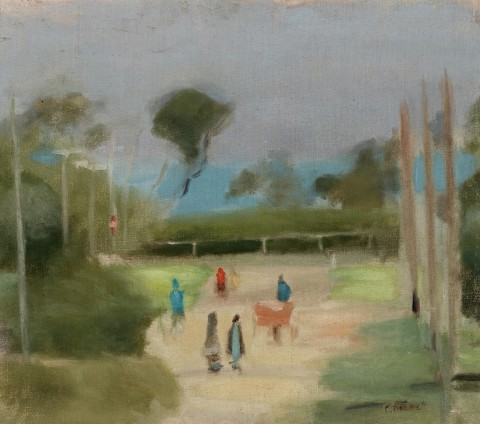OUT WALKING, c.1928 – 29
CLARICE BECKETT
oil on canvas on board
29.0 x 34.5 cm
signed lower right: C. Beckett
Mrs Hilda Mangan, Victoria, the artist’s sister
Rosalind Humphries Galleries, Melbourne
Sonia Grodeck, Melbourne, acquired from the above in 1971
Private collection, Melbourne
Mossgreen, Melbourne, 11 October 2015, lot 1
Private collection, Sydney
Homage to Clarice Beckett (1887 – 1935): Idylls of Melbourne and Beaumaris, Rosalind Humphries Galleries, Melbourne, 30 October – 20 November 1971, cat. 63
We are grateful to Rosalind Humphries for her assistance with this catalogue entry.
Out Walking, c.1928 – 29, depicts a view close to Clarice Beckett’s home in the Melbourne bay-side suburb of Beaumaris. Beckett moved there from Casterton, near Bendigo, in 1919 with her parents whose health was failing; and the suburb is aptly named, being a truncation of the French ‘beau marais’, meaning ‘beautiful marsh’. Following Melbourne’s European settlement, Beaumaris became a popular holiday destination noted for its winding coastal trails, atmospheric tangles of ti-tree and capacious views over Port Phillip Bay. At the base of the weathered sandstone cliffs lie secluded beaches and rock ledges full of fossils. Beckett would return to these familiar sites many times throughout her career – and in all weathers – to such an extent that it is impossible to walk the same territory today and not see it through her eyes.
The family lived at ‘St. Enoch’s’ in Dalgetty Road, and Out Walking shows that street’s intersection with Beach Road, with the shimmering blue of the bay beyond. Beckett would already have been a familiar sight to locals, as she walked the paths with her hand-built painting trolley. Her painting technique was aligned to the group of artists called the ‘tonalists’ who gathered around Max Meldrum; and the trolley, in fact, had a particular use beyond mere transport. ‘Tonalist works were created to be viewed, when complete, from a distance of about six metres (approximately twenty feet). The painting process required much to-ing and fro-ing between the subject and the observation point by both the painter and the painting … Consequently to assist with this process, many of the artists constructed custom-built wheeled easels or painting trolleys. Clarice Beckett was one of the first to adopt a trolley.’1 This description of the dedicated process involved in constructing such images belies the spontaneous sensation given by Out Walking, that of a snapshot briefly glimpsed before being captured in a hurried application of paint. As noted by the curator Ted Gott, ‘Beckett’s compositions have an elusive, phantasmic mystique. [By comparison] everything in our world today is sharp, crystal clear, hard and fast.’2 Not surprisingly, critics often attached the term ‘Whistler-ian’ to her work.
Judging by the long coats, Out Walking was painted on an early Spring morning, with the overcast sky punctured at points by sunshine which illuminates patches of the sandy road and grassed verge. To the left, a carer in a blue coat watches a red-caped girl as she rushes towards the intersection. Two older ladies in grey hats and coats walk the other way, deep in conversation; and, crunching the unsealed road between them, the hand-propelled cart in the middle-centre. The rows of telegraph poles create a frame within the frame, anchored horizontally by the white fence line indicating the cliff path. To the left, a flash of muted red indicates an emergency box, a tiny detail of colour which links visually to the girl’s cape and the man’s cart. Like the companion work with the same title,3 Beckett’s paintings of pedestrians are predominantly solo studies, making this version of Out Walking one of the rarer compositions to include small groups of people.
We are grateful to Rosalind Hollinrake for her assistance with this catalogue entry.
1. Lock-Weir, T., Misty Moderns: Australian tonalists 1915 – 1950, Art Gallery of South Australia, Adelaide, 2008, p.46
2. Gott, T., ‘Foreword’, Clarice Beckett: 1887 – 1935, Niagara Galleries, Melbourne, 29 February – 1 April 2000, p.5
3. Rosalind Hollinrake describes this alternate version as being of Beckett’s young niece Patricia walking along the cliff top path.
ANDREW GAYNOR
